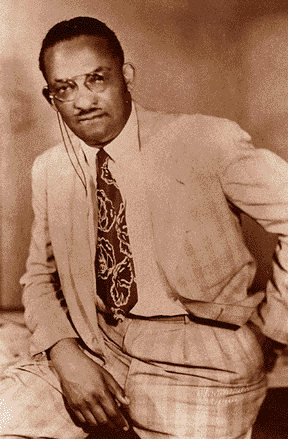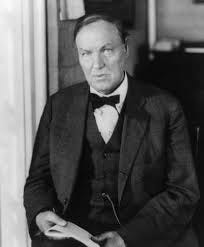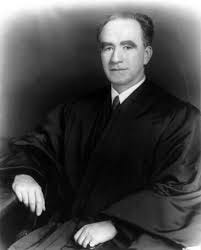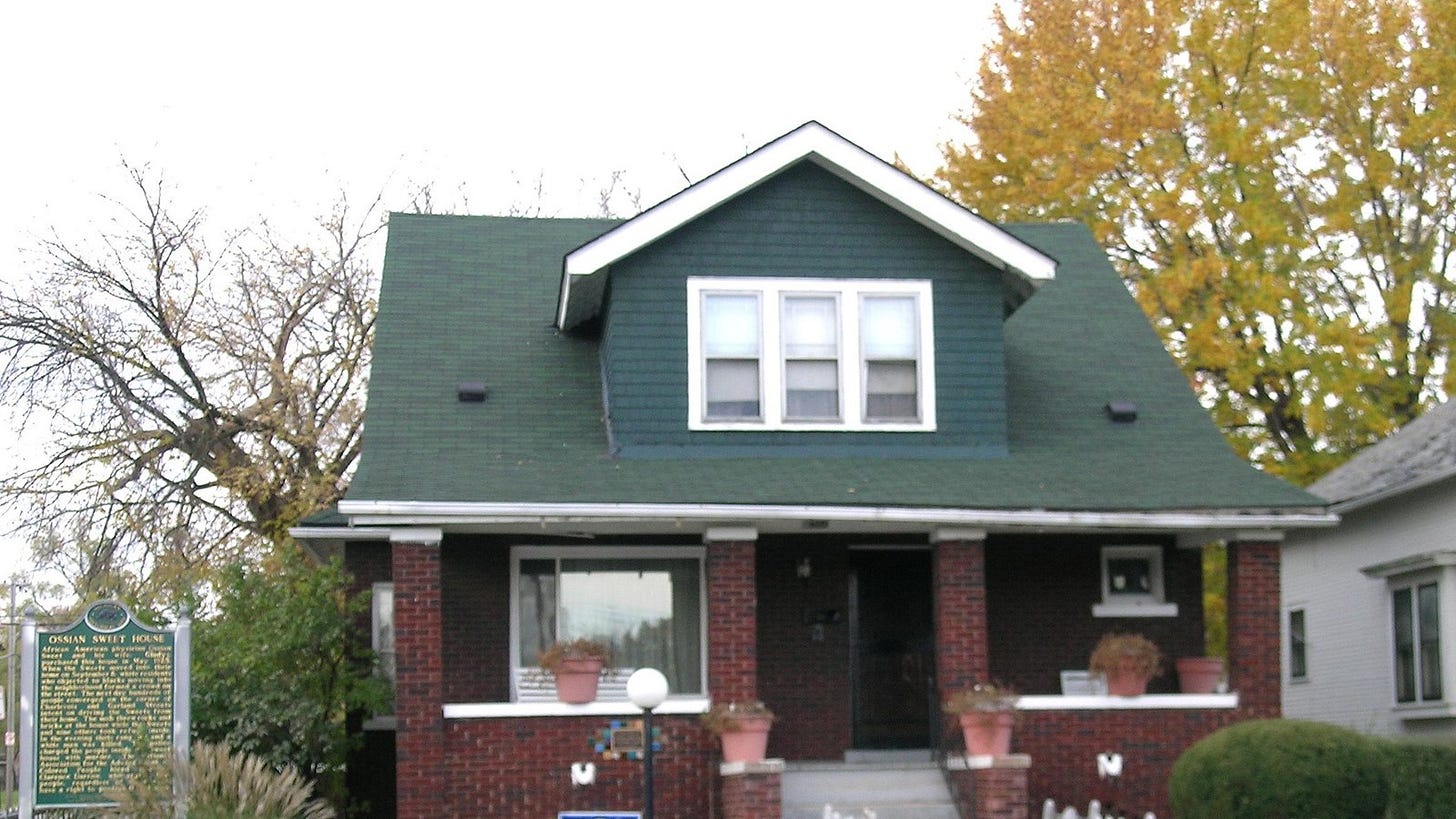Today In Black History: The Saga of Dr. Ossian Sweet
Turmoil, Triumph, and Death in Detroit's Racial Divide
Issue #842 Today In Black History, Wednesday, April 16, 2025
If you like us, REALLY like us, please click the “Like” button at the end of this post!
Your “Likes” mean a LOT to us! We appreciate your support!
Engage with us and our posts in Substack Notes, where we post almost daily.
Our April, 2025 subscriber goals are 200 new free subscribers and 100 new paid subscribers! You can help us reach our goal!
Follow Pam on Bluesky, the best “X” alternative.
Follow Keith on Bluesky, the best “X alternative.
Independent Authors and Creative Professionals: books and courses on Branding and Marketing just for you via Pam Speaks 2 You.
We appreciate your support!
A Desire for Equality
The early 20th century in America was marked by racial segregation that permeated every facet of life, from education and employment to housing. During this time, in 1925, Dr. Ossian Sweet, an African-American physician born in 1895 in Barstow, Florida, and a graduate of the HBCU Howard University Medical School, sought to purchase a home in a predominantly white neighborhood in Detroit. Driven by a desire to provide a better life for his family and assert his right to live where he chose, Sweet's actions challenged the systematic racism ingrained in society.
The Move-In and The Mob
About one hundred years ago, on September 8, 1925, Dr. Sweet and his wife Gladys and several friends and family members moved into the house at 2905 Garland Street. The move was met with hostility from white neighbors, who were determined to maintain racial homogeneity in their community. Within a short span, a menacing crowd gathered outside the Sweet residence, hurling stones and threats, intent on forcing the Sweets to leave.
The Night of Violence
The tension reached a catastrophic climax on the night of September 9, 1925. As the mob grew increasingly violent, stones shattered the windows of Sweet's home. In fear for their lives, shots were fired from within the house, killing one white man and injuring another in the crowd outside. This incident led to the arrest of Dr. Sweet, his family, and friends on charges of murder.
The Trial and Clarence Darrow
The following trial was a watershed moment in the fight against racial discrimination. Dr. Sweet's defense team included the legendary attorney Clarence Darrow, who advocated civil liberties and human rights. The national NAACP hired Mr. Darrow.
After 26 hours of deliberation, the jury returned without a verdict. Presiding Judge Frank Murphy, who would later become governor of Michigan and an Associate Supreme Court Justice, declared a mistrial and released Dr. Sweet.
Clarence Darrow, a renowned lawyer famous for his eloquent defense of individuals in high-profile trials, played a pivotal role in the trial of Dr. Ossian Sweet. Darrow's involvement in this case is one of the most celebrated episodes in his illustrious career, which is marked by several landmark trials highlighting his commitment to civil liberties and social justice.
Previous Famous Trials Involving Clarence Darrow:
The Leopold and Loeb Case (1924):
Just a year before the Sweet trials, Clarence Darrow defended Nathan Leopold and Richard Loeb, two wealthy University of Chicago students who were accused of kidnapping and murdering 14-year-old Bobby Franks. The case shocked the nation due to its brutality and the defendants' motive of committing the "perfect crime." Darrow's defense focused on saving the young men from the death penalty by emphasizing their psychological conditions and presenting a powerful argument against capital punishment. His passionate 12-hour plea is considered one of the most remarkable in legal history, resulting in life sentences instead of execution.
The Scopes "Monkey" Trial (1925): In one of the most famous trials in American history, Darrow defended John T. Scopes, a high school teacher accused of violating Tennessee's Butler Act, which prohibited teaching human evolution in state-funded schools. The trial became a sensational clash between modernist and traditionalist values, with Darrow opposing William Jennings Bryan, a three-time presidential candidate and ardent creationist. Although Scopes was found guilty, Darrow's relentless questioning and advocacy for academic freedom impacted the debate over educational curriculum and the separation of church and state.
Debs Sedition Case (1918): Earlier in his career, Darrow defended Eugene V. Debs, a prominent socialist leader charged under the Espionage Act for a speech criticizing World War I. Although Debs was convicted, Darrow's defense emphasized the importance of free speech and political dissent. This trial highlighted Darrow's steadfast commitment to defending individuals against government overreach and his dedication to civil liberties.
In the trial of Dr. Ossian Sweet, Darrow applied his exceptional legal skills in a racially charged context. He argued that Dr. Sweet and his associates acted in self-defense amid a hostile mob intent on threatening their safety. Darrow’s defense emphasized not only legal principles but also broader themes of racial equality and justice, advocating for the rights of African Americans to live where they choose without fear of violence or retribution. The case ended with a hung jury in the first trial. Still, Darrow's efforts were crucial in the eventual acquittal of Dr. Sweet in a subsequent trial, marking a significant victory against racial injustice and affirming the right to self-defense in the face of mob aggression.
A Victory for Justice
The trial's first iteration ended in a hung jury. In the subsequent retrial, which focused solely on Ossian's younger brother, Henry Sweet, the jury delivered a verdict of not guilty. This outcome was a symbolic victory, reflecting a growing awareness and rejection of the racial injustices that plagued the nation.
After the trials, Dr. Ossian Sweet's life continued to be marked by personal and professional challenges, largely as a result of the social and racial tensions surrounding the events of 1925.
Post-Trial Life and Career:
Following the trials, Dr. Sweet faced significant difficulties in resuming his career. Although he was acquitted, the notoriety from the trial made it challenging for him to practice medicine without prejudice. The stigma attached to the case affected his professional life, and despite the legal victory, racial discrimination persisted in society.
Tragic Personal Life:
Tragedy continued to shadow Dr. Sweet’s personal life. His wife, Gladys Sweet, contracted tuberculosis, a disease that was rampant during that era and exacerbated by stress and poor living conditions. Gladys's health deteriorated, and she ultimately succumbed to the illness in 1926, just a year after the trials. Their daughter, Iva, also passed away from tuberculosis shortly thereafter, intensifying the personal losses Dr. Sweet endured.
Dr. Sweet’s Later Years and Death:
Dr. Sweet remained in Detroit despite these personal tragedies and advocated for civil rights. However, the continued stress and setbacks had a profound impact on his well-being. Over the years, he faced financial hardships and could not fully recover the life and career he once envisioned.
Dr. Ossian Sweet's life came to a tragic end in 1960. He was found deceased in his home on March 20, having died by suicide. His death underscored the relentless toll that systemic racism and personal loss had taken on him throughout his life.
The Ossian Sweet House is an important historical landmark in Detroit, recognized for its powerful connection to the fight for racial equality and civil rights in America. It symbolizes both the courage and the struggles faced by African Americans in the early 20th century, particularly in the context of housing discrimination. The house is now privately owned and not open to the public.
The Significance of the Ossian Sweet House:
Challenge to Segregation: Dr. Ossian Sweet's attempt to integrate a predominantly white neighborhood in Detroit was a direct challenge to the racial segregation of the time. His decision to purchase and move into the house at 2905 Garland Street in September 1925 exemplified the broader struggle for African American rights and equality in housing.
Symbol of Resistance: The house stands as a symbol of resistance against racial violence and prejudice. The Sweets' resolve to stay in their home despite the violent opposition they faced, and the legal battles that ensued, represent a poignant chapter in the civil rights movement long before it gained national momentum in the mid-20th century.
Commemoration of Struggles and Triumphs: The designation of the Ossian Sweet House as a historical landmark reminds us of the personal and collective struggles African Americans have endured in the quest for equality. It honors the sacrifices and resilience of those who dared to fight systemic injustices, paving the way for future generations.
Educational Value: It serves as an educational site where people can learn about the history of racial segregation, the legal battles for civil rights, and the personal stories of those who stood against discrimination.
Today In Black History
In 1862, President Abraham Lincoln signed the District of Columbia Emancipation Act, which ended slavery in the District and paid out about $1,000,000 in reparations to former slaves. April 16 is celebrated in D.C. as DC Emancipation Day, a local holiday for the entire city, including the federal government.
In 1868, Louisiana voters approved a new state constitution banning segregation in public accommodations. The voters also elected Oscar J. Dunn as the state’s first Black lieutenant governor and Antoine Dubuclet as its first Black state treasurer.
In 1869, Ebenezer Dan Carlos Bassett became the first African American to serve in a U.S. diplomatic post when he was appointed Consul-General to Haiti and the Dominican Republic.
In 1895, Black inventor C.J. Dorticus received a patent for his photo embossing machine.
In 1962, three Louisiana segregationists were excommunicated by Archbishop Joseph Rummel for continuing their opposition to his order for the integration of New Orleans parochial schools.
In 1963, Rev. Dr. Martin Luther King, Jr. wrote the Letter from the Birmingham Jail, where he was incarcerated for demonstrating for civil rights.
In 1965, Assistant Deputy Chief of Staff of the U.S. Air Force. Force, Major General Benjamin Olivier Davis, Jr., was named Lt. General, the highest rank attained by a Black person in the armed forces to date.
In 1973, Lelia Smith Foley became the first Black woman mayor in the U.S. after being elected by the voters of Taft, OK.
In 1977, author Alex Haley found his Roots in Juffure, Gambia.
In 1980, the African nation of Zimbabwe(formerly Rhodesia) declared its independence from Great Britain.
In 1987, playwright August Wilson was awarded the Pulitzer Prize for his play “Fences.”
In 2018, Kendrick Lamar became the first rapper and non-classical or jazz musician to the Pulitzer Prize with his album “Damn.” He “not like us!” He “not like us!” IYKYK!
All “We Are Speaking” posts are now free for everyone to read, and commenting on our posts is now open to everyone!
Share this post:
Share this publication:
Our subscriber goals for April 2025 include 200 new free subscribers and 100 new paid subscribers. Click the link to help us reach our goals!
Our paid subscribers are encouraged to discuss this post in our W.A.S. Chat Community.
Join Pamela Hilliard Owens’s subscriber chat
Available in the Substack app and on the web
You are also welcome to view “We Are Speaking” in Substack Notes. You can also read other Substack publications without subscribing to them when you join Notes.
Did you know that you can listen to each “We Are Speaking” post and engage directly with us on the Substack App? Download the app!
Please check out Keith’s AfroFantasy Detroit Substack for posts about fantasy, sci-fi, and Afrofuturism!











This is a story everyone should know and which must not be forgotten. Bravo Pamela and Keith!
I know posts like these are the end result of a lot of work and a lot of time. Thanks for what you both do.